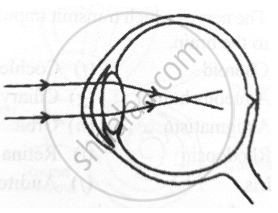Advertisements
Advertisements
प्रश्न
Explain the functions of the following parts of the eye:
(i) cornea
(ii) iris
(iii) pupil
(iv) ciliary muscles
(v) eye-lens
उत्तर
Functions of the parts of the eye:
(i) Cornea: The front part of the eye that is made of a transparent substance and is convex in shape is called the cornea. The light from an object enters the eye through the cornea.
(ii) Iris: The iris is a flat, coloured and a ring-shaped membrane with a hole in the middle called the pupil. The iris regulates and controls the amount of light entering the eye by automatically adjusting the size of the pupil according to the intensity of light that the eye receives.
(iii) Pupil: The pupil is a hole in the middle of the iris and appears black because there is no light reflected from it. The pupil expands or contracts to regulate the amount of light entering the eye.
(iv) Ciliary muscles: The ciliary muscles contract or relax the eye lens and help in changing its focal length to focus the images of nearby or distant objects on the retina.
(v) Eye lens: The eye lens is a convex lens whose main function is to the converge the light rays from an object and form a real and inverted image of the object on the retina.
APPEARS IN
संबंधित प्रश्न
Compare the following: Choroid and retina
Differentiate between: Rods and cones
Fill in the following blank with suitable word:
Most of the refraction of light rays entering the eye occurs at the outer surface of the.............
What changes take place in the shape of eye-lens:
when the eye is focused on a near object?
The eyes of a person are focused (i) on a nearby object, and (ii) on a distant object, turn by turn. In which case:
the focal length of eye-lens will be the maximum?
Suggest how your irises help to protect the retinas of your eyes from damage by bright light.
Write whether the following is true or false:
Rods are the receptor cells in the retina of the eye sensitive to dimlight.
Draw a labeled diagram of the front view of human eye.
State the Function:
Aqueous humour
Given below is a diagram depicting a defect of the human eye. Answer the questions that follow:

- Give the scientific term for the defect.
- Mention one possible reason for the defect.
- What type of lens can be used to correct the defect?
